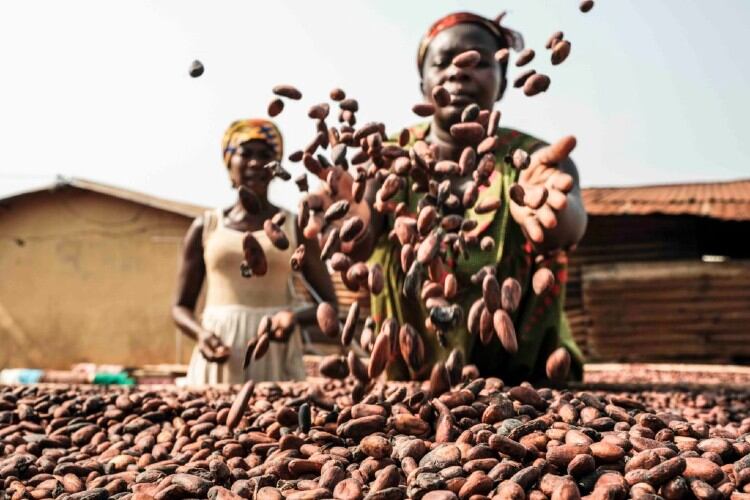Cote d’Ivoire, the world’s leading producer of cocoa, is on track to achieve a record cocoa harvest. In July, Reuters reported that by September, an estimated 2.3 million tonnes of cocoa beans will arrive at Ivorian ports ready for export.
With some reports suggesting deforestation in Cote d’Ivoire and Ghana has increased in recent years more than anywhere else in the world, this bumper harvest poses two questions: where exactly is this cocoa coming from? And have tropical forests been cleared in order to produce it?
We need traders, brands and retailers to be more active in engaging with cocoa growing communities where they source cocoa from. Only by understanding their challenges can we hope to put plans and support in place to change their methods, improve their livelihoods, and restore forests. Furthermore, they need to consult farmers and create solutions with them
The two West African countries produce around 60% of the world’s cocoa, which is grown exclusively by approximately two million cocoa smallholders. Yet they remain a largely isolated and unknown group of people. According to a report by Forest Trends and Supply Change, just nine of the top 69 leading chocolate companies are able to trace their cocoa bean supplies to individual farms.
This needs to change quickly if tropical forests are to be restored in and around cocoa growing areas, providing the conditions necessary to grow cocoa in the first place. There are some exceptions, Lindt & Sprüngli has traced 100% of its cocoa beans back to source. While our Ivorian field team at Earthworm Foundation is supporting Nestlé, the Ivorian Ministry of Waters and Forestry (MINEF) and the National Forestry Agency (SODEFOR), to restore Cavally Forest Nature Reserve in Cote d’Ivoire.
Part of this work involved interviewing 755 people across cocoa growing communities in 66 villages at the periphery of the Cavally forest reserve. Our findings highlight the wider challenges faced by the cocoa industry and the farmers that supply them.
We discovered 86% feel their income was insufficient to meet their basic needs; and just as tellingly, 90% believing the only land available to them to plant their crops is in the fertile soil within the forest reserve. While a quarter estimating their annual revenues are below $380, putting them below the national poverty line in Cote d’Ivoire.
Food security and farmers
This underlines a wider global trend when it comes to food security and farmers. In July, the United Nations revealed almost a third of the world not having enough food to eat, as the Covid pandemic highlighted the importance of investing in rural areas, with small scale farmers being the most reliant providers of food and as such require investment. Cocoa farmers very much fit that bill, with poverty being a driver of cocoa related deforestation.
There are tools readily available to monitor deforestation. For example, satellite technology to identify it happening is being deployed. Although using such data to exile farmers from the forest will not solve the problem in the long run. They will simply find another area in which to plant. Finding out why they are clearing forests can help the industry create plans with farmers to give them the opportunity to change their practices.
Our research in Cavally has identified five different groups of people who are financially tied to forest nature reserve. They are:
- Local people growing crops to feed their families.
- Farmers from other areas of the country, along with migrants, the vast majority of whom are from neighbouring Burkina Faso, with plantations in the reserve who pay a fee to those in group five below.
- Farmers from outside the region who farm in the reserve without paying fees.
- Employees who work in plantations and earn a salary or proportion of the harvest, and in the case of migrant farmers they are often friends and family of the farmers.
- Those whose income is dependent on people from outside the area paying them to for their crops in the reserve.
Employment opportunities
The general profile of those farming outside the forest is that of wanting to expand their farm and their activities. While those planting inside say they do so due to lack of employment opportunities and the quality of the soil within the forest where land is perceived as free and fertile. Although these farmers see a possibility of leaving the forest if they found better ways to earn an income.
We need traders, brands and retailers to be more active in engaging with cocoa growing communities where they source cocoa from. Only by understanding their challenges can we hope to put plans and support in place to change their methods, improve their livelihoods, and restore forests. Furthermore, they need to consult farmers and create solutions with them.
Engagement activities can include working with farmers to map their farms and nearby forest boundaries, as well as working with local government and forestry agencies to patrol forests – it helps when there is satellite data of deforestation patterns to help target where to patrol. Another important area to consider investment in is projects to improve their cocoa yields, while also identifying further and alternative sources of income. This can complement any tree replanting efforts. Such work can help create more resilient farming communities and healthy forests.

